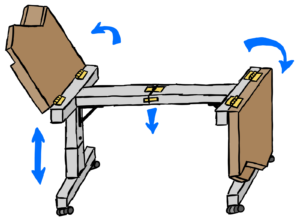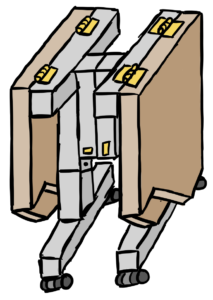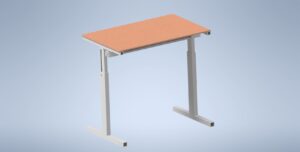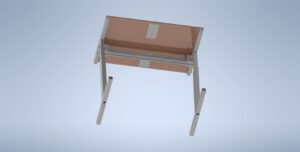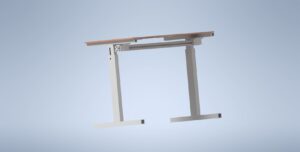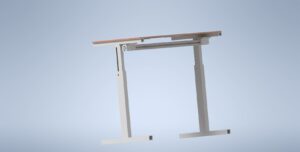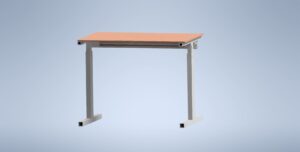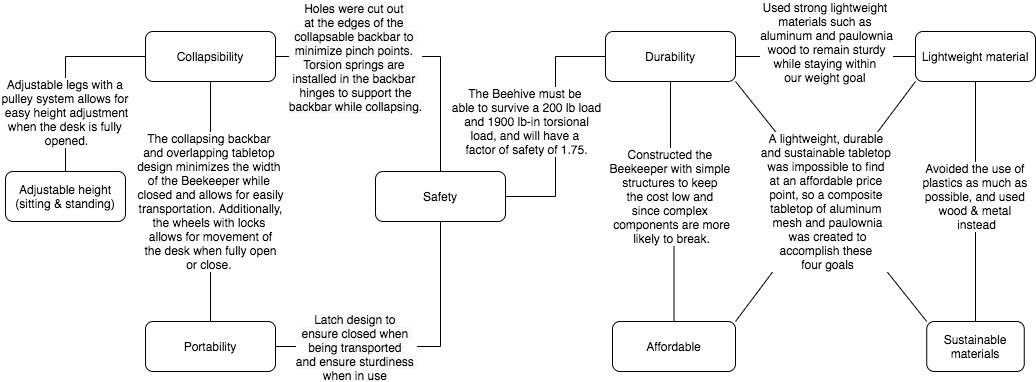The Beekeeper is a portable desk that is designed to allow children to easily adjust the height of the desk from sitting to standing height, while also allowing them to transport the desk between home and their classroom. The adjustable legs will include a telescoping beam mechanism to provide safe, simple, and quick height adjustment at incremental heights at a range of 18 to 36 inches. After a complete collapse, the folded desk can be pulled by a luggage handle and moved by its wheels to its next location.
To aid with portability, lightweight materials such as aluminum and paulownia wood are being used. The desk will have an overall weight of about 12 pounds and support a maximum compressive load of 200 pounds on any point of the tabletop and a maximum torsional load of 1900 pound-inches on the corners of the desk. Along with the strength of the material, extra design consideration for the material was made to balance cost, sustainability, and durability. Using ADA guidelines, the weight requirements, and functionality, the tabletop is 19 inches by 30 inches. The Beekeeper will include slots on top of the tabletop to secure the Beehive’s environment walls.
The team successfully completed its first prototype, which met all design goals except for a simultaneous raising and lowering of the desk legs to change height. After learning much form the first prototype, the team is currently redesigning many sub-systems and will have a second prototype available for testing by April 5, 2021. New design features include a better engineered back rail that folds in half for disassembly; an origami-inspired cut for the tabletop that will eliminate the need for hinges and thus eliminate some pinch points; new, smaller wheels to make the desk more functional and portable; and a pulley and retraction mechanism system for raising and lowering both desk legs at the same time via a lever.
Current (Second) Prototype
First Prototype
Linked below are some videos showcasing the functionality of the first prototype:
Functional Decomposition
Specifications
The table below describes the specifications guiding the design process for this product. Quantitative values and specific materials are indicated where applicable. Solutions to the concerns surrounding the majority of the design considerations came from design conversations among team members. Those that involve specific sizing dimensions came from government specifications provided by the United States Access Board.
| Specification | Engineering Solution | Design Choices | Supporting Analysis / Experimental Results | |
| 1 | Durability: waterproof, long-lasting, and able to support a load of 200 pounds at any point on the tabletop and a torsional load of 1900 pound-inches on the corners of the tabletop. | All materials are waterproof and rust resistant to account for everyday wear and tear in addition to spills. The desk needs to be able to support large loads in the case that adults use the desk. | Strength analysis and material selection is based off of these expected loads. | All product choices were made with this constraint in mind. Only high quality, long-lasting materials are being used. |
| 2 | Portability | Wheels and handle for easy transportation | The design was adapted to be supported on wheels, and the legs were designed with the ability to include a luggage handle. | The desk will be portable and collapsible for easy transportation in a hybrid learning atmosphere. The main goal of this desk is to ease the transition between learning from the classroom and learning from home. So, the desk is fully collapsible to allow for portability. |
| 3 | Affordability with price limit of $150 | Inexpensive materials were selected for the unique composite, as many pre-made composite materials are quite expensive. | Design choices were made to simplify the fabrication process and eliminate the need for an excessive amount of pricey custom pieces. Mounting strategies were chosen with inexpensive materials in mind, for example the tabletop attaches by a hinge affixed with screws. | The materials are to be as cost effective as possible while still meeting all required design needs, as one of the main goals for this desk is to be accessible regardless of socioeconomic status. |
| 4 | Height range of 18-36” | Height adjustment is possible through a complex retraction mechanism and pulley system. | The retraction mechanism and pulley system allow one to adjust the height of the desk through a singular lever. This system is currently in the proof-of-concept construction phase. | Both the open and collapsed dimensions must cater to the size of a child. Dimensioning should be in compliance with ADA recommendations, as the desk is designed to be wheelchair accessible. |
| 5 | Weight of 12 lbs or less | Lightweight and hollow materials were selected to ensure that the weight of the structure is child-friendly. | A lightweight tabletop composite material consisting of aluminum mesh and paulownia wood was chosen. Hollow aluminum beams were also selected. | Weight restrictions guided material selection greatly. Government recommendations suggest children should push no more than 20% of their bodyweight. |
| 6 | Safety | Each system is designed to limit pinch points and allow students to safely collapse, assemble, and transport the desk. | Torsion springs are used in various places to ensure that collapsing the different subsystems can be done slowly and smoothly. | A large factor of safety was selected for strength analysis of the desk to prevent tipping and collapsing under heavy loads. |
| 7 | Collapsibility | All components of the desk will collapse into a structure of no more than 12” in width | The legs are able to come together through a collapsable support system. The back bar hinges to rest between the desk legs when collapsed, and the tabletop hinges in half as well as over to the left for storage while collapsed. The wheels allow easy motion of the right leg to the left side. | The student will easily be able to collapse the desk safely through the usage of torsion springs, levers, and lockable hinges. |
| 8 | Sustainability | Materials that can be justified as sustainably sourced (e.g. bamboo, recycled metal, recycled plastic) | Materials selected for the desk don’t have a large environmental footprint. | With sustainability in mind, second semester goals include selecting sustainably sourced material for desk construction. The difficulty with this will come with finding a balance between weight and sustainability, as one cannot be compromised for the other. |

